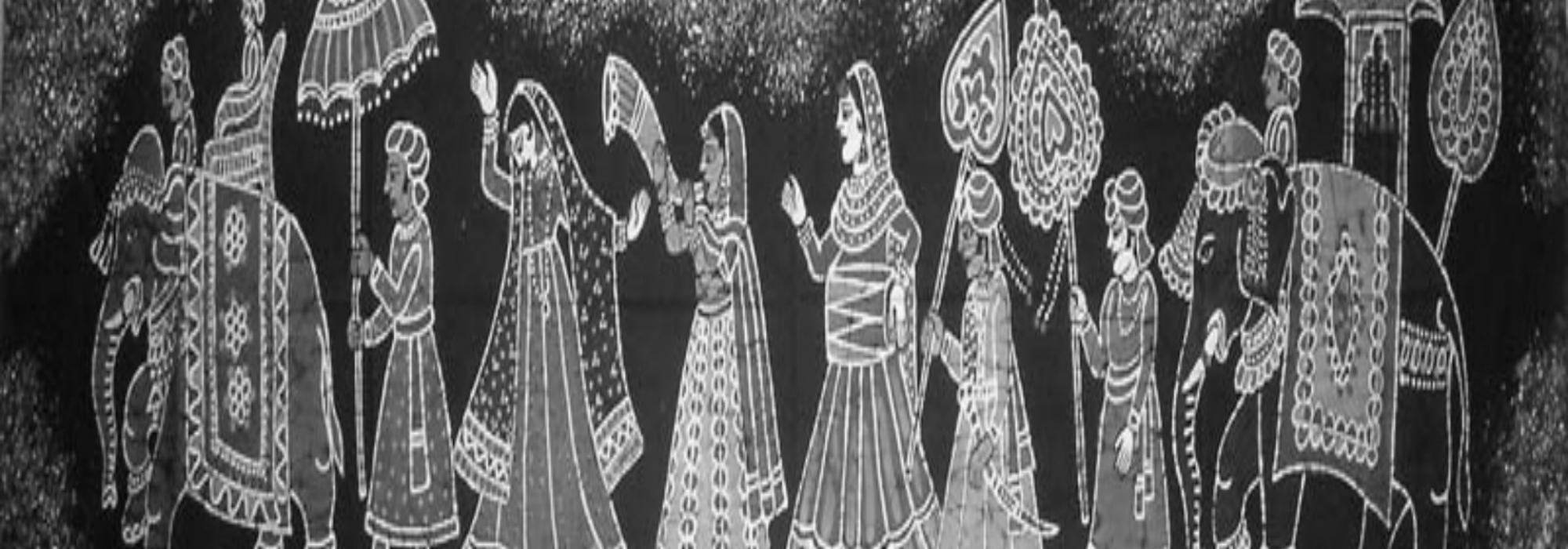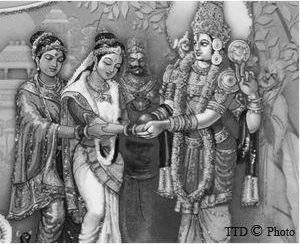The Sanskrit word for wedding is विवाह (vivaaha). Vivaaha also means ‘marriage.’ Basically it refers to “supporting dharma.” Dharma is a Sanskrit word that means ‘harmony,’ ‘sustainability,’ ‘righteousness,’ ‘welfare at large’ – in essence, ‘that which is most beneficial to the world.’ The wife is referred to as sahadharmini, an equal partner in upholding dharma and treading the right path. The wedding is typically performed with mantras from the Vedas. The sacred fire, the embodiment of universal energy, sanctifies the wedding as the foremost witness.
The Indian conception is that a marriage brings two families together. It is a serious commitment of a man and a woman towards each other and towards the well-being of their families. Husband and wife form the wheels of the chariot of their life, which need to move in the same direction and at the same speed.
A happy marriage is based on mature love and not infatuation. It requires selflessness and vigil. A successful marriage is a healthy partnership in which both partners work to make it work. The Vedas say, “Gathering wealth with a spirit of sacrifice, united in mutual love, they serve the supreme.”
Running a home according to the rules of the गृहस्थाश्रम—the householder phase—involves acquiring noble qualities including tolerance, self-sacrifice, and an altruistic attitude. Thus marriage rounds off the development of human character which started developing even in the embryo.
The ancient Indian tradition recognized eight kinds of marriages:
1. Braahma vivaaha
After the student-bachelor (ब्रह्मचारि) has completed studies in the gurukula, the girl's parents give their daughter in marriage to him. In a sense, the girl is "gifted" (कन्यादानम्) to the boy's family. A marriage arranged like this is ब्राह्म विवाह. This is considered the purest form of marriage where a woman gets married to a man of learning. This type of marriage is highly regarded by the smritis. The classic example is the marriage of Suryaa with Soma.
2. Praajaapatya vivaaha
प्राजापत्य विवाह, as the name suggests, is intended as a bond between a man and a woman for procreating and mindfully clearing their debts to Prajaapati. Here, the bride's parents or elders give their daughter in marriage to a suitor on the condition that they would observe religious and secular duties together. This is the most common traditional arranged marriage. Krishna’s parents Devaki and Vasudeva were married in this way.
3. Daiva vivaaha
Getting a girl married to a ऋत्विक् (officiator of the ritual) during a Vedic yajna is called दैव विवाह. Rama’s sister Shanta is said to have been given in marriage to Rishyashringa, who officiated the पुत्रकामेष्टि यज्ञ. This form of marriage was considered inferior to the Braahma type.
4. Aarsha vivaaha
आर्ष विवाह is a kind of marriage where the bridegroom gives the bride's father a pair of cows, which were required for rituals. This was not meant as a price for the girl (and thus is different from the Aasura type). This type of marriage perhaps took place when the parents of the girl could not celebrate her marriage in the प्राजापत्य विवाह method.
5. Gaandharva vivaaha
This is love marriage, which is so popular and has such enthusiastic following these days. In this case, no parents or elders are involved. The man and woman meet each other of their own accord. This was not considered scandalous. A classic example is that of Shakuntala and Dushyanta.
6. Aasura vivaaha
In this case, the groom is in no way a match for the bride, but her father or relatives receive a good deal of money from the man who asks them to marry her to him.
7. Raakshasa vivaaha
The groom takes away the girl by force, not waiting for the permission of her parents or even the girl herself. The groom battles with girl’s family, overcomes them, and carries the girl away. In some cases, the groom takes the bride with her consent. It was in this manner that Arjuna married Subhadra (of course with Krishna’s encouragement and much to Balarama’s chagrin.)
8. Paishaacha vivaaha
Here the girl’s wishes do not count nor is any money or material given to the parents. She is seized, when unconscious, against her wish and her family is antagonized.
Ours was a highly evolved system, which is still there to see; but it has been complicated and overpowered by many of our sutrakaaras.
Interestingly the (actual) vivaaha mantras found in the ekagni kanda of Krishna Yajur Veda (mostly drawn from Rig Veda 10.85, ‘seen’ by the rishika Suryaa, the daughter of Surya) was meant for the bride groom and bride to say (and not the purohita). Also they clearly indicate that both the bride and groom were adults and ready to hit the sack. Some of the muddled authors of the grihyasutras—perhaps the first abomination of the Vedic system of thought—reduced the age of the bride to eight years, and even cradle weddings were encouraged and lauded. It went to a point that they declared that if a girl is not married before puberty, then all sorts of horror will follow after death. Many girls used to commit suicide and sometimes even the fathers of girls would fall in a well to avoid such infamy.
However, some of the sutrakaaras were astute enough to indicate that all their pronouncements are bound by space and time – what was applicable in a certain era in a certain location would not be so forever. Also, since there were such a wide variety of works and writers on matters relating to marriage, there was an opportunity for multiple views and an ecosystem of tolerance.
Reference
Pujyasri Chandrashekharendra Sarasvati Svami. Hindu Dharma: The universal way of life. Bombay: Bharatiya Vidya Bhavan, 1995 (pp. 572-77)
Thanks to Shashi Kiran B N and Hari Ravikumar for their edits.

















































Comments